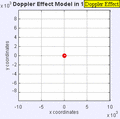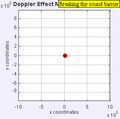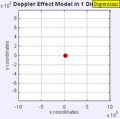Doppler effect facts for kids
The Doppler effect is a change in frequency and wavelength of a wave. It is caused by the change in distance between the thing creating the wave (causer) and whatever is measuring seeing or hearing the wave (watcher or observer).
Another word for "causer" is "sender" or "source". Another word for "change in distance" is "speed" or "relative velocity". A common example is sitting in a car while another car goes by the watcher. The watcher will hear a change in pitch, while the sender will not.
For waves read all the waves that can send out or reflected by an object. And for reflection read change of direction of a wave.
Effects of changes in distance
If observer and creator of the wave get closer, the frequency is higher and the wavelength is shorter.
- For light, this causes a shift in colour towards the blue end of the spectrum called a blue shift. The faster something is moving toward us, the greater the blue shift.
- For sound, this causes the sound to become higher in pitch
If the distance between the observer and creator gets longer, the frequency is lower and the wavelength is longer.
- For light, this causes a shift towards the red end of the spectrum called a red shift, the faster something is moving away, the greater the red shift.
- For sound, this causes the sound to become lower in pitch.
Light waves can also be read, examples are:
- Microwaves
- Radio waves
An extreme example of the doppler effect is an aeroplane flying at a faster speed than the speed of sound and how the wall of sound is heard on the ground.
Related pages
Images for kids
-
Colour flow ultrasonography (Doppler) of a carotid artery – scanner and screen
-
Stationary sound source produces sound waves at a constant frequency f, and the wave-fronts propagate symmetrically away from the source at a constant speed c. The distance between wave-fronts is the wavelength. All observers will hear the same frequency, which will be equal to the actual frequency of the source where f = f0.
-
The same sound source is radiating sound waves at a constant frequency in the same medium. However, now the sound source is moving with a speed υs = 0.7 c. Since the source is moving, the centre of each new wavefront is now slightly displaced to the right. As a result, the wave-fronts begin to bunch up on the right side (in front of) and spread further apart on the left side (behind) of the source. An observer in front of the source will hear a higher frequency f = c + 0c – 0.7c f0 = 3.33 f0 and an observer behind the source will hear a lower frequency f = c − 0c + 0.7c f0 = 0.59 f0.
-
Now the source is moving at the speed of sound in the medium (υs = c). The wave fronts in front of the source are now all bunched up at the same point. As a result, an observer in front of the source will detect nothing until the source arrives and an observer behind the source will hear a lower frequency f = c – 0c + c f0 = 0.5 f0.
-
The sound source has now surpassed the speed of sound in the medium, and is traveling at 1.4 c. Since the source is moving faster than the sound waves it creates, it actually leads the advancing wavefront. The sound source will pass by a stationary observer before the observer hears the sound. As a result, an observer in front of the source will detect nothing and an observer behind the source will hear a lower frequency f = c – 0c + 1.4c f0 = 0.42 f0.
See also
 In Spanish: Efecto Doppler para niños
In Spanish: Efecto Doppler para niños










